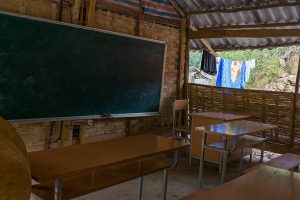
Disadvantages of Schools in Rural Areas

Disadvantages of Schools in Rural Areas: Limited Access to Resources and Opportunities. Rural areas often face unique challenges when it comes to education. The disadvantages of schools in rural areas can impact students’ academic success and future opportunities.
One of the main challenges of schools in rural areas is infrastructure. Many rural schools lack the resources and funding to provide students with modern technology and facilities. This can limit students’ access to educational resources and hinder their ability to learn. In addition, rural schools often struggle with teacher shortages, making it difficult to provide students with quality instruction in all subject areas.
Another issue facing rural schools is educational quality. Due to limited resources and funding, rural schools may not be able to offer the same level of academic programs and extracurricular activities as schools in more urban areas. This can limit students’ exposure to different subjects and careers, and make it more difficult for them to pursue higher education or career opportunities later in life.
Key Takeaways
- Rural schools often face infrastructure challenges that can limit students’ access to technology and quality facilities.
- Limited resources and funding can make it difficult for rural schools to offer the same level of academic programs and extracurricular activities as urban schools.
- Teacher shortages in rural areas can impact students’ ability to receive quality instruction in all subject areas.
Infrastructure Challenges
Rural schools face significant infrastructure challenges that can negatively impact the quality of education provided to students. Two of the most significant infrastructure challenges faced by rural schools are poor facilities and lack of technology access.
Poor Facilities
Many rural schools lack basic infrastructure for sanitation, water, roads, and other transportation. The socio-economic realities of rural areas put learners in rural schools at a disadvantage. According to a study by Semantics Scholar, some rural schools in the US are housed in buildings that are over 50 years old and are in need of significant repairs and renovations.
Poor facilities can negatively impact the quality of education provided to students. For example, inadequate heating and cooling systems can create uncomfortable learning environments, which can lead to decreased student performance. In addition, poor lighting and acoustics can make it difficult for students to hear and see instruction, which can also negatively impact student performance.
Lack of Technology Access
Another significant infrastructure challenge faced by rural schools is a lack of technology access. Many rural schools lack access to basic technology infrastructure, such as high-speed internet and modern computer systems. This lack of access can make it difficult for students to learn and for teachers to provide effective instruction.
According to an article by K12 Dive, the COVID-19 pandemic has highlighted the technology access gap in rural schools. With many schools transitioning to remote learning, students in rural areas have struggled to access the internet and participate in online classes.
In conclusion, poor facilities and lack of technology access are significant infrastructure challenges faced by rural schools. These challenges can negatively impact the quality of education provided to students and make it difficult for teachers to provide effective instruction.
Educational Quality
Rural schools often struggle to provide the same level of educational quality as their urban and suburban counterparts. This is due to a variety of factors, including limited resources, a smaller pool of qualified teachers, and a lack of access to technology and other educational tools.
Limited Curriculum
One of the major challenges facing rural schools is a limited curriculum. Many rural schools lack the resources to offer a full range of courses, particularly in areas such as foreign languages, advanced math and science, and the arts. This can put rural students at a disadvantage when it comes to college admissions and career opportunities.
Underqualified Teachers
Another issue facing rural schools is a shortage of qualified teachers. Many rural areas struggle to attract and retain teachers due to lower salaries, limited resources, and a lack of professional development opportunities. As a result, rural schools are more likely to have underqualified teachers, which can lead to lower educational outcomes for students.
To address these challenges, policymakers and educators must work together to provide more resources and support for rural schools. This could include initiatives such as increased funding for technology and professional development, as well as targeted efforts to recruit and retain qualified teachers in rural areas. By investing in rural education, we can help ensure that all students have access to high-quality educational opportunities, regardless of where they live.
Access and Attendance Issues
Rural schools in the United States face several challenges that can impact student attendance and access to education. These challenges include transportation difficulties and high dropout rates.
Transportation Difficulties
Transportation can be a significant barrier to attendance for rural students. Many students live in remote areas without access to public transportation, making it difficult for them to get to school. According to an article on Edutopia, some students may have to travel long distances on buses, and bad weather conditions can make it even more challenging.
To address this issue, some schools have implemented creative solutions, such as carpooling and providing transportation for students who live far away. However, these solutions can be costly and may not be feasible for all schools.
High Dropout Rates
High dropout rates are another significant issue facing rural schools. According to a report by the New York Times, students in rural areas are more likely to drop out of school than their urban and suburban counterparts. This can be due to several factors, including a lack of resources and support, a shortage of teachers, and limited access to extracurricular activities.
To combat this issue, some rural schools have implemented programs to provide additional support and resources to at-risk students. These programs may include tutoring, mentoring, and counseling services. However, these programs can be costly and may not be available at all schools.
In conclusion, disadvantages of schools in rural areas face problems in transportation difficulties and high dropout rates are significant challenges facing rural schools in the United States. While some schools have implemented solutions to address these issues, more needs to be done to ensure that all students have access to quality education.
Limited Extracurricular Opportunities
One of the major disadvantages of schools in rural areas is the limited extracurricular opportunities that are available to students. Due to the lack of resources and funding, many rural schools are unable to offer a wide range of extracurricular activities such as sports teams, music programs, and clubs. This can be a significant disadvantage for students who are interested in pursuing these activities and may limit their opportunities for personal growth and development.
In many cases, rural schools may only be able to offer a few extracurricular activities, and these may not be of interest to all students. For example, a school may have a football team, but not offer other sports such as basketball or volleyball. This can be particularly challenging for students who are interested in pursuing a sport that is not offered at their school.
Furthermore, due to the small size of many rural schools, there may not be enough students to form a team or club, which can limit opportunities for students to participate in extracurricular activities. This can be particularly challenging for students who live in isolated areas and may not have access to other community-based programs.
Overall, the limited extracurricular opportunities in rural schools can be a significant disadvantage for students who are interested in pursuing personal growth and development outside of the classroom. While some schools may be able to offer a few activities, many students may not have access to the full range of opportunities that are available in larger schools or urban areas.
Conclusion on disadvantages of schools in rural areas
In conclusion, disadvantages of schools in rural areas face numerous challenges that hinder the quality of education provided to students. The lack of resources, including funding, technology, and qualified teachers, is a significant disadvantage for rural schools. This leads to a lower quality of education, which in turn affects the future prospects of students.
Moreover, the isolation of rural areas can lead to a lack of diversity in the student body, which can impact the social and emotional development of students. Additionally, rural areas often lack access to healthcare, which can affect the physical well-being of students.
Despite these challenges, there are efforts being made to improve the situation. For example, the Rural Education Achievement Program provides funding and support to rural schools. Additionally, technology can help bridge the gap between rural and urban areas by providing access to resources and educational opportunities.
Overall, it is important to recognize the unique challenges faced by rural schools and work towards finding solutions that can improve the quality of education provided to students in these areas.
Frequently Asked Questions on disadvantages of schools in rural areas
What are some of the challenges faced by students attending schools in rural areas?
Students attending schools in rural areas face numerous challenges that are not experienced by their urban counterparts. Some of these challenges include a lack of access to quality reading materials and instruction, limited access to medical care, and the impact of opioid abuse and child homelessness in low-income and rural communities.

What impact does the lack of resources have on education in rural schools?
The lack of resources in rural schools can have a significant impact on education. This includes limited access to technology, outdated textbooks, and a shortage of qualified teachers. These factors can lead to lower academic performance and reduced opportunities for students.
How do rural schools compare to urban schools in terms of academic performance?
On average, rural schools tend to perform lower than urban schools in terms of academic performance. This is due in part to the challenges faced by rural schools, such as limited resources, difficulty attracting and retaining qualified teachers, and a lack of access to the latest educational technologies.
What are some of the disadvantages of poor school facilities in rural areas?
Poor school facilities in rural areas can have a significant impact on education. This includes outdated and inadequate buildings, limited access to technology, and inadequate heating and cooling systems. These factors can lead to reduced opportunities for students and lower academic performance.
What are the main factors that contribute to the lack of education in rural areas?
The lack of education in rural areas can be attributed to a variety of factors, including poverty, limited access to educational resources, and a shortage of qualified teachers. Additionally, many rural communities lack the necessary infrastructure to support education, such as transportation systems and adequate healthcare.
What are the challenges faced by school leaders in rural areas?
Disadvantages of Schools in Rural Areas; School leaders in rural areas face a number of challenges unique to their environment. These challenges include limited resources, difficulty attracting and retaining qualified teachers, and a lack of access to the latest educational technologies. Additionally, rural school leaders must navigate the complex social dynamics of small communities and work to build strong relationships with families and community members.









Leave a Reply